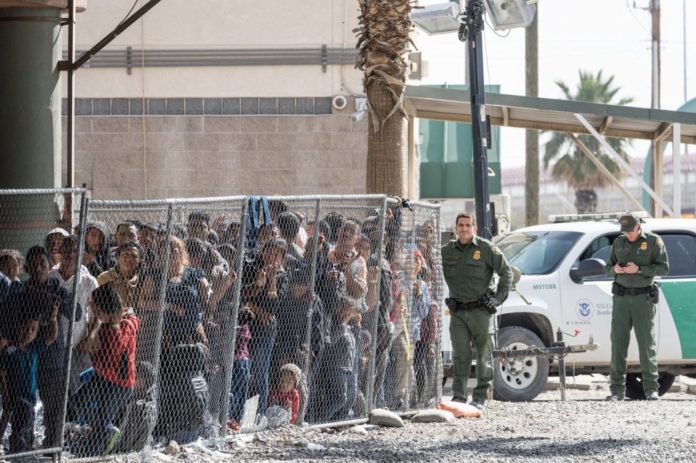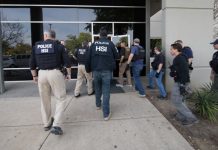
Feb. 1 (UPI) — Four women who came to the United States seeking asylum from persecution in their home countries allege in a federal lawsuit that Trump administration officials targeted them with exorbitant civil fines because they took sanctuary in churches and spoke out against “unjust and punitive” deportation orders.
The Austin Sanctuary Network in Texas and the Philadelphia-based Free Migration Project also are plaintiffs in the suit, which was filed in U.S. District Court in Washington, D.C., on Jan. 19, the day before President Joe Biden took the oath of office. Officials with the Department of Homeland Security and Immigration and Customs Enforcement are named as defendants.
The ASN and FMP say they have been forced to divert resources from their missions to respond to the actions taken against the women, who are leaders in a movement to change sanctuary and deportation policies. All four are indigent and were fined about $60,000 each as punishment for their advocacy, the suit claims.
The Immigration and Nationality Act has authorized the use of civil fines for failing to depart the United States since 1952 but those provisions began to be enforced only after then-President Donald Trump signed an executive order in 2017 calling on the Department of Homeland Security secretary to ensure the collection of the penalties, the suit alleges.
“The targeted sanctuary leaders all have engaged in significant organizing, including vigils, rallies and congressional visits — all motivated by their deeply held religious beliefs — to raise awareness of their dire circumstances and the cruelty of deportation policies,” the suit also says. “Many of the targeted sanctuary leaders participate in the National Sanctuary Collective, supported by organizations like plaintiffs ASN and FMP, to respond to developments in immigration policy and to advocate for fair and just responses, all of which has a religiously grounded approach.”
The plaintiffs allege violations of their First Amendment rights of freedom of speech and association and the free exercise of religion; the Eighth Amendment right to be free of excessive fines; and the Religious Freedom Restoration Act, which prohibits the federal government from substantially burdening a person’s exercise of religion. They also claim retaliation for exercising their free speech and association rights.
The suit seeks an order barring the defendants from selectively enforcing civil immigration fines and unspecified monetary damages.
The plaintiffs believe they have a religious duty “to welcome the stranger (Matthew 25:35 ‘I was a stranger and you welcomed me’) and to participate collectively to prevent vulnerable human beings and their families from being sent back to countries and conditions that would threaten their lives or well-being,” the suit says.
‘Trapped’ inside churches
Plaintiff Hilda Ramirez-Mendez, who fled violence in Guatemala in 2014 with her son, has been in sanctuary for five years at St. Andrew’s Presbyterian Church in Austin, Texas. After learning in early 2016 that they were going to be deported, Ramirez and her son, who is now 14, found sanctuary at St. Andrew’s. (The teen had since been approved for a Special Immigrant Juvenile Status Visa, which allows him to seek lawful permanent residence in the United States.)
“I believe that churches are holy places and I don’t believe any harm can come to you inside and I don’t believe immigration officers should be able to enter,” Ramirez-Mendez, an evangelical Baptist who has embraced the Presbyterian faith, said through an interpreter.
The other plaintiffs include Edith Espinal, who came to the United States from Mexico more than 20 years ago with her family and has been in sanctuary since 2017 at the Columbus Mennonite Church in Ohio. Espinal was raised Catholic but has been involved in the Mennonite community since taking sanctuary, the suit says.
Another plaintiff, Vicky Chávez, a Honduras native and evangelical Christian, has integrated her religious practices into the activities of the First Unitarian Church in Salt Lake City, where she has been living since 2018, according to the suit.
And fellow plaintiff Maria Chavalán Sut, who is from Guatemala, has been in sanctuary at the Wesley Memorial United Methodist Church in Charlottesville, Va., since 2018. She grew up practicing Mayan and Roman Catholic religious traditions, among others.
Leaders of the National Sanctuary Collective held a virtual press conference on Tuesday calling for Biden to lift the deportation orders against each person living in sanctuary. They said some immigrants have been “trapped” inside churches for years under the threat of being deported and separated from their families.
In addition, 30 members of Congress and a group of several dozen elected officials, convention delegates and candidates for office have sent separate letters to the president making the same request. The congressional letter says 40 people are living in places of worship across the nation as they fight deportation.
“We’re asking the administration to take immediate action because this is an urgent situation given how long the sanctuary leaders have suffered in isolation,” David Bennion, FMP executive director, told UPI.
Bennion pointed out that the Biden administration has halted most deportations for 100 days to review enforcement priorities (though a judge has temporarily blocked the order) and said his organization thinks it will be open to the requests.
Birth of a movement
The modern-day sanctuary movement formed in the 1980s, when hundreds of thousands of Central Americans fled to the United States to escape civil war. The Central Americans sought humanitarian help under the 1980 Refugee Act, but they were specifically targeted for deportation, immigrant advocates allege.
The situation prompted Southside Presbyterian Church in Tucson, under the direction of the Rev. John Fife and with the support of congregants, to become a sanctuary in 1982. The church is considered by many to be the birthplace of the Sanctuary Movement.
“In the ’80s, the whole focus of the sanctuary movement was to protect refugees fleeing the death squads and the violence and the repression and the massacres of literally hundreds of villages in Central America, to protect them as refugees from capture and deportation,” Fife, who at 81 is retired, said in a recent interview.
The movement was primarily faith-based, with hundreds of congregations and faith groups in the nation eventually providing shelter at houses of worship, Fife said. Cities and universities also began joining.
Volunteers based at Southside provided aid and temporary shelter to thousands of Central Americans. The work went on even after sanctuary leaders — including Fife, two Catholic priests, a nun and seven church lay workers — were charged with various counts of conspiracy and other federal crimes. Eight, including Fife, were convicted in 1986 and all sentenced to probation.
The movement also pushed for changes in immigration law and in the 1990s, Congress passed legislation that allowed the suspension or cancelation of deportation for many asylum seekers from Central America.
But anti-immigrant rhetoric and rising detentions in the 2000s led to the New Sanctuary Movement, and a network of more than 800 Christian, Jewish, Muslim, Hindu, Sikh, Baha’i and Buddhist houses of worship opened their doors to immigrants at risk of deportation, the suit says. The effort increased even more as the number of deportations rose during the Obama administration.
Now, many congregations and organizations helping immigrants are part of the initiative and their services include more than physical shelter, said the Rev. Dr. Donna Schaper, senior minister at Judson Memorial Church in New York City.
“We have come to define sanctuary very broadly, not just as physical sanctuary. We call it the sometimes moral, sometimes legal, sometimes physical offering of hospitality to people who are in danger,” said Schaper, who co-founded the New Sanctuary Coalition of New York City, a multi-faith organization, in 2007.
Among the coalition’s programs is one that assigns citizen volunteers to accompany immigrants to their court hearings and periodic check-ins with ICE. The organization also holds clinics to train people on how to apply for asylum and fight their own deportation case.
In addition, the New Sanctuary Coalition assists immigrants in accessing healthcare, nutrition programs, adult education and other services.
Fighting deportations
Communities and congregations around the country are working together to assist immigrants who are fighting deportation.
In Olympia, Wash., Temple Beth Hatfiloh extended protection in 2019 to a woman who had fled Guatemala with her son because she was a victim of domestic violence. The congregation is being helped by other organizations, including the Greater South Sound Network for Immigration and Refugee Support, a coalition of faith communities.
Rabbi Seth Goldstein said the genesis of the decision to take in the two goes back to rhetoric in the 2016 presidential election around immigration, including the proposal to build a wall along the U.S.-Mexican border. The congregation spent a long time studying how to help immigrants in Olympia, which became a sanctuary city in 2016, and the surrounding area.
“We thought through the issues very thoroughly,” Goldstein said. “We were inspired by the work of others.”
In Minneapolis, Daniel Romero, who serves as community minister for immigration with the Lyndale United Church of Christ and the Interfaith Coalition on Immigration, works with the Sanctuary State campaign to push for laws that will provide protections for undocumented people.
In addition to immigrants living in traditional sanctuary, “there are also many people living in situations where they’re trying to be as off the grid as they can be, hoping and waiting for a policy change that would enable them to get some kind of status,” Romero said.






